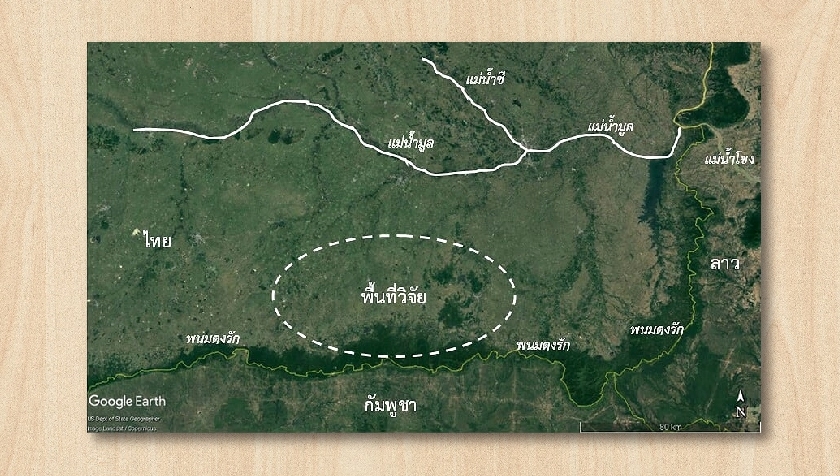
ลำดับอายุของการตั้งถิ่นฐานทางโบราณคดีเขตเทือกเขาพนมดงรักฝั่งตะวันออก
The Settlement Chronology in the Eastern Region of Phnom Dongrek Range
โดย สุรีรัตน์ บุบผา / By Sureeratana Bubpha
Damrong Journal, Vol 18, No.1, 2019
บทคัดย่อ:
การศึกษาลำดับอายุของการตั้งถิ่นฐานในพื้นที่เทือกเขาพนมดงรักฝั่งตะวันออกต่อเนื่องกับที่ราบลอนลาดในเขตจังหวัดศรีสะเกษนั้น มีการสำรวจทั้งภาคสนามและเอกสารที่เกี่ยวข้อง ซึ่งได้พบการตั้งถิ่นฐานของประชากรโบราณตั้งแต่ยุคก่อนประวัติศาสตร์ตอนปลายต่อเนื่องสู่ยุคประวัติศาสตร์ จำนวน 38 แห่ง โดยปรากฏการตั้งถิ่นฐานตั้งแต่ยุคก่อนประวัติศาสตร์ตอนปลาย (สมัยเหล็ก) สืบเนื่องเข้าสู่ยุคประวัติศาสตร์ในวัฒนธรรมเจนละ วัฒนธรรมทวารวดี วัฒนธรรมเขมร วัฒนธรรมล้านช้าง และวัฒนธรรมรัตนโกสินทร์ ซึ่งหลักฐานเหล่านี้ต่างบ่งชี้ว่า เมื่อมีพัฒนาการเข้าสู่สังคมที่มีความซับซ้อนในช่วงประวัติศาสตร์แล้วนั้น การตั้งถิ่นฐานได้กระจายลงมาสู่พื้นที่ราบมากขึ้นอย่างชัดเจน โดยมีชุมชนบางแห่งที่อาจมีสถานะเป็นศูนย์กลาง กระจายอยู่ตามจุดต่าง ๆ ทั้งนี้แม้การเพิ่มจำนวนมากขึ้นของชุมชนยุคประวัติศาสตร์อย่างชัดเจน โดยเฉพาะอย่างยิ่งชุมชนในวัฒนธรรมเขมรที่พบเป็นจำนวนมากในเขตที่ราบนั้น จะบ่งชี้ถึงความสัมพันธ์กับการเพิ่มจำนวนประชากรและตอบสนองต่อความต้องการพื้นที่การผลิต โดยเฉพาะการเพาะปลูกข้าว แต่ก็ยังพบว่าเขตพื้นที่สูงนั้นยังคงมีการใช้พื้นที่อย่างต่อเนื่องที่สัมพันธ์กับคติทางศาสนา อย่างไรก็ตาม การใช้พื้นที่ควบคู่กันทั้งในเขตที่สูงและที่ราบลอนลาดนั้นเป็นแบบแผนการตั้งถิ่นฐานและการเลือกใช้พื้นที่ที่ปรากฏมาตั้งแต่ยุคก่อนประวัติศาสตร์และต่อเนื่องเข้าสู่สมัยประวัติศาสตร์ ทว่าข้อสังเกตประการหนึ่งที่พบคือการใช้พื้นที่ในเขตที่สูงช่วงยุคก่อนประวัติศาสตร์สัมพันธ์กับทั้งการใช้พื้นที่เพื่ออยู่อาศัย หรือเพื่อกิจกรรมทางศาสนาเพียงอย่างใดอย่างหนึ่ง หรือผสมผสานระหว่างพื้นที่อยู่อาศัยกับพื้นที่กิจกรรมศาสนา ในขณะที่ช่วงยุคประวัติศาสตร์นั้น ไม่ปรากฏว่ามีการใช้พื้นที่ในเขตที่สูงเพื่อการอยู่อาศัยเป็นหลักเพียงอย่างเดียวดังที่เคยปรากฏในช่วงก่อนประวัติศาสตร์
ABSTRACT:
This research is an archaeological fieldand documentation survey, regarding settlement chronology, across an area adjacent to the eastern part of the Phnom Dongrek Range in Sisaket resulting in the discovery of 38 ancient communities, in both the prehistoric and historical periods. Among the newly discovered communities most can be classifiedas prehistoric sites in Iron Age, Chenla period, Dvaravati period, Khmer period, Lan Xang period, and the Rattanakosin period. With respect to site function, it can be seen that some locations were mainly occupied as a single purpose, for example, either living or religious purposes, whereas some sites were used for both living and religious purposes. In historical period, the data also suggests that a single function of the site, based on its religious purpose, was dominant by comparing with those other function patterns. Furthermore, the data also illustrates that the highland area was used mainly as a single function habitation area, whereas the same pattern cannot be found in the historical period through sub-cultural phases. It is found that, in the historic era, lowland areas were more favourable than highland areas as settlement locations, especially in the Khmer period. The data indicates that the number of communities in lowland areas was considerably larger than in highland areas. Different factors, for example, religion, population increase, cultivation requirement, were potentially associated with such settlement pattern changing overtime from prehistoric to historic periods respectively.











